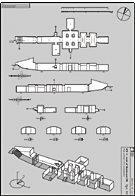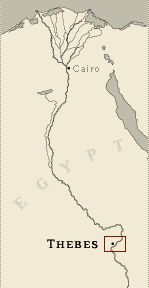|
KV 3 (Son of Rameses III)
General Site Information
Structure: KV 3
Location: Valley of the Kings, East Valley, Thebes West Bank, Thebes
Owner: Son of Rameses III
Other designations: 1er Tombeau à l'est [Description], 3 [Hay], 3 [Lepsius],
5 [Champollion], O, plan N (?) [Pococke], P [Burton]
Site type: Tomb
Description
KV 3, located in the first southeast
branch off the main wadi, resembles in plan tombs of royal family
members of Dynasty 20 in the Valley of the Queens. Its open entryway
(A) leads to a corridor (B) from which side chambers were to open
off each side (Ba, Bb). Only the right (south) side chamber Bb was
fully cut; a cutting on the left (north) marks the beginning of the
gate and side chamber Ba. A pillared chamber (F) follows on the main
axis, also with side chambers (Fa, Fb). Here, the left (north) side
chamber Fa was completed, while on the right (south) Fb is
represented only by the abandoned gate cutting. On the same main
axis, three smaller chambers (G, H, J) occupy the rear; the first
two have vaulted ceilings.
The tomb's extant decoration in painted sunk relief on plaster
survives only in corridor B, as well as gates B and F. The principal
decorative theme consisted of depictions of Rameses III followed by
a prince, before various deities. It is assumed that the decorative
program was complete, however, since Carl Richard Lepsius noted
painted decoration on the ceiling of the vaulted chamber and
depictions of the king on the walls of the first corridor B, as well
as gates B and C.
Noteworthy features
This is one of the few decorated tombs
of a prince in the Valley of the Kings. It has two narrow rear
chambers, with vaulting at ninety degrees to the usual form.
Site History
An ostracon in the Berlin Museum (Berlin Ostracon P.10663) records
that in regnal year 28 of Ramesses III a group of workmen went to
the Valley of the Kings to "found the [tomb] of a prince of His
Majesty." The tomb may be KV 3, but the name of the prince is
unknown, although some have suggested that it was intended for the
prince who succeeded his father as Rameses IV. There are no
indications that the tomb received a royal burial. Bricks and
remains of sandstone columns indicate that KV 3 was used as a
Christian chapel during the Byzantine Period.
Dating
This site was used during the following period(s):
-New Kingdom, Dynasty 20, Rameses III (dated by the presence of the
king's cartouches)
-Byzantine Period
History of Exploration
Pococke, Richard (1737-1738): Mapping/planning
Burton, James (1825): Mapping/planning
Franco-Tuscan Expedition (1828-1829): Epigraphy
Lepsius, Carl Richard (1844-1845): Visit
Ayrton, Edward Russell (1904-1906): Excavation (conducted around
entrance)
Quibell, James Edward (1904-1906): Excavation (conducted around
entrance)
Burton, Harry (1912): Excavation (conducted for Theodore M. Davis)
Conservation
-
Conservation history: A rubble revetment was constructed around the
entrance, together with a wall across the entry. A metal gate has
been installed in gate B, partly covering inscriptions on the
thicknesses.
-
Site condition: The painted plaster wall decoration has almost
entirely fallen away except near the ceiling in corridor B. A
coating of smoke from recent burning of trash in the corridor
entrance has damaged the ceiling.
|

Printable Tomb Drawings
Axis in degrees: 68.56
Axis orientation: East
Site Location
Latitude: 25.44 N
Longitude: 32.36 E
Elevation: 167.246 msl
North: 99,695.005
East: 94,136.424
JOG map reference: NG 36-10
Modern governorate: Qena (Qina)
Ancient nome: 4th Upper Egypt
Surveyed by TMP: Yes
Measurements
Maximum height: 3.13 m
Minimum width: 1.03 m
Maximum width: 7.71 m
Total length: 53.47 m
Total area: 193.36 m²
Total volume: 464.98 m³
Additional Tomb Information
Entrance location: Base of sloping hill
Owner type: Prince
Entrance type: Ramp
Interior layout: Corridor and chambers
Axis type: Straight
Decoration
Sunk relief
Categories of Objects Recovered
Architectural elements
Vessels
|

